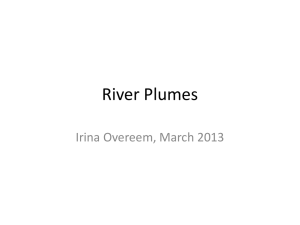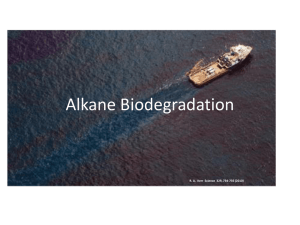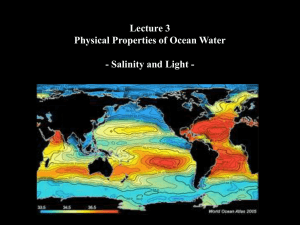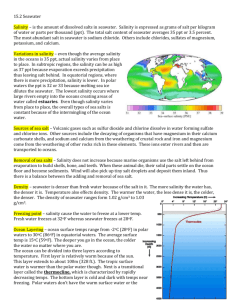Motyka et al LeConte Suppl Mat GRL ver 6
advertisement
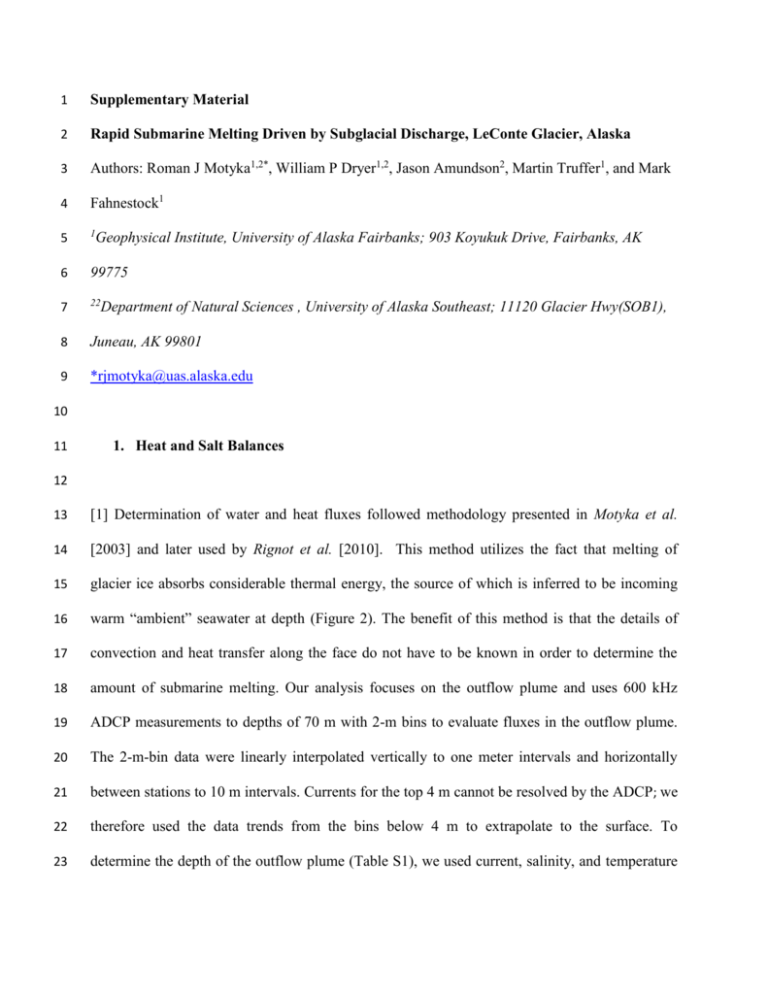
1 Supplementary Material 2 Rapid Submarine Melting Driven by Subglacial Discharge, LeConte Glacier, Alaska 3 Authors: Roman J Motyka1,2*, William P Dryer1,2, Jason Amundson2, Martin Truffer1, and Mark 4 Fahnestock1 5 1 6 99775 7 22 8 Juneau, AK 99801 9 *rjmotyka@uas.alaska.edu Geophysical Institute, University of Alaska Fairbanks; 903 Koyukuk Drive, Fairbanks, AK Department of Natural Sciences , University of Alaska Southeast; 11120 Glacier Hwy(SOB1), 10 11 1. Heat and Salt Balances 12 13 [1] Determination of water and heat fluxes followed methodology presented in Motyka et al. 14 [2003] and later used by Rignot et al. [2010]. This method utilizes the fact that melting of 15 glacier ice absorbs considerable thermal energy, the source of which is inferred to be incoming 16 warm “ambient” seawater at depth (Figure 2). The benefit of this method is that the details of 17 convection and heat transfer along the face do not have to be known in order to determine the 18 amount of submarine melting. Our analysis focuses on the outflow plume and uses 600 kHz 19 ADCP measurements to depths of 70 m with 2-m bins to evaluate fluxes in the outflow plume. 20 The 2-m-bin data were linearly interpolated vertically to one meter intervals and horizontally 21 between stations to 10 m intervals. Currents for the top 4 m cannot be resolved by the ADCP; we 22 therefore used the data trends from the bins below 4 m to extrapolate to the surface. To 23 determine the depth of the outflow plume (Table S1), we used current, salinity, and temperature 24 profiles. We also used a Gade melt line analyses described in Mortensen et al. [2011] to 25 determine the fraction of submarine glacier meltwater in the water column. 26 27 [2] Spacing between stations was a compromise between temporal and spatial resolution. In 28 order to resolve tidal effects, we strove to complete each transect in 2 hr or less. To provide 29 adequate spatial resolution, we attempted to space our stations about 200 m apart or less. In 30 practice, time per station and distance between stations averaged 2.2 hr and 190 m respectively 31 (Table S2). The number of stations occupied per transect varied from 5 to 7. 32 33 1.1 Salt Balance 34 [3] The total water flux in the outflow plume, Qp, was calculated by numerically integrating the 35 measured, interpolated, and extrapolated currents across the flux gate: 36 Qp = WD ui(x,z) dxdz 37 (1) 38 39 where ui(x,z) are the 600 kHz ADCP velocities, D is the plume depth, and W the width of the 40 flux gate. Some flow along the walls is missed by our stations. 41 42 [4] The water discharge in the outflowing plume, Qp, has both seawater, Qsw, and freshwater, 43 Qfw, components: 44 45 46 Qp = Qsw + Qfw = Qsw + Qsg + Qm (2) 47 where Qsg and Qm are the subglacial discharge and terminus ice melt, respectively. The fraction 48 of seawater in the overflow plume was determined from the salinity. Subglacial discharge, Qsg, 49 and glacier melt Qm, are assumed to have zero salinity and to be at the pressure melting point. 50 We used Ssw = 28 PSU and Tsw = 6.8 °C for ambient seawater salinity and temperature; these 51 were the average salinity and temperature in the lowest part of the water column (~ 170 – 180 52 m). We estimated the fraction of seawater (s ) in the plume at a depth z from 53 s = Sp(z)/Ss 54 (3) 55 56 where Sp is the measured salinity in the plume. The seawater flux in the outflow plume is then 57 given by 58 Qsw = WD ui(x,z) si(x,z) dxdz 59 (4) 60 61 Equation (4) was numerically integrated using 600 kHz ADCP velocities, ui(x,z), and Spi(x,z) 62 obtained from CTD casts. 63 64 [5] The freshwater flux in the outflow plume, Qfw, was determined from eqn. 2. 65 66 1.2 Heat Balance 67 [6] From conservation of mass, the incoming deep ambient seawater flux must be equal to the 68 flux of seawater in the outgoing plume and we use Qsw to evaluate Qm. From conservation of 69 energy, the heat coming into the system via the warm seawater, Hsw, and via the subglacial water, 70 Hsg, must equal the heat leaving the system in the plume, Hp, plus the latent heat lost to melting 71 ice, Hm: 72 Hm = H = Hsw + Hsg - Hp 73 (5) 74 75 Here we neglect heat generated by friction and heat lost to the atmosphere, and we assume that 76 Hsg = 0 because the ice and subglacial water are at 0 C, which is our reference state. We 77 determine the incoming heat flow from 78 Hsw = sw Qsw Csw Tsw 79 (6) 80 81 where Csw is the specific heat (3990 J kg-1 K-1), sw is the density (1022 kg m-3), Tsw is the 82 temperature of the deep seawater (6.8 C) and where, from conservation of seawater in the fjord, 83 the rate of seawater inflow near the terminus is assumed to be equal to outflow of seawater in the 84 plume, Qsw, which was calculated above. 85 86 [7] Heat carried away from the terminus by the overflow plume was computed by numerically 87 integrating across the flux gate: 88 89 90 H p = WD ( pi ui C p T pi )dx dz (7) 91 using the measured and interpolated values of mixed-water density, temperature, and velocity 92 within the plume. The heat capacity of the plume water was taken to be that of seawater, Csw. 93 The rate of ice melt, Qm, is then computed from: 94 Qm = Hm L-1 95 (8) 96 97 where L is the latent heat of fusion for ice. An adjustment for saltwater melting-point depression 98 of approximately -1.0 C was included in this calculation. Qsg is then evaluated from Qfw and Qm 99 (eqn. 2). 100 101 2. Error Analysis 102 103 [8] The SeaCAT temperature and salinity values are highly accurate, ±0.005 °C and ±0.007 PSU 104 respectively; thus the primary sources of uncertainty in our methods stem from current 105 measurements, interpolations, and extrapolations. The accuracy for ADCP current 106 measurements is reported to be 1 cm/s when averaging 50 pings [RDI, pers. comm., 2012]. We 107 preformed a sensitivity analysis on our 600 kHz ADCP data sets, each of which usually consisted 108 of 200+ pings. We divided data for each 2-m bin into two populations, odd and even numbered 109 (or every other ping), and then computed the average velocity, Uodd and Uev, of each data set of 110 100+ pings for each bin. Uodd and Uev for each bin were then differenced for all ADCP casts 111 (1250 total bins). The results produced a normal distribution with a mean of ~ 0 and a standard 112 deviation, σ, of 1.5 cm/s. We interpret this σ to be a measure of variance in currents due to 113 inherent fluctuations. We opted to use 2σ as a conservative estimate of uncertainties for each 114 individual current measurement. Given the normal distribution of the comparison, we consider 115 the error to be random. Therefore, to estimate total uncertainty in flux through the gate, we used 116 σ1 = 2σ√n2, where n is the number of current measurements made across the gate. These 117 uncertainties ranged from 3% to 6.5% of the total flux values. Additional uncertainties accrue 118 from horizontal interpolations and extrapolations. Temperature and salinity varied little 119 horizontally across the transects, so linear interpolation of T and S is unlikely to introduce 120 significant errors. There was variation in currents across the gate; however distances between 121 stations were small enough that we consider linear interpolation to be a reasonable 122 approximation. To be conservative, we added an additional 5% uncertainty to our flux estimates 123 to account for potential uncertainties in our interpolations and extrapolations. These uncertainties 124 apply to the temporal (~2 hr) and spatial (~ 90 m wide swath) averages of each survey. 125 126 Table S1. Characteristics of outflow plume. 127 Transect Peak Depth of Width of Depth of Tide Time local velocity, peak vel, plume, plume, stage cm/s m m m T3, 9/7 40 27 450 45 ↑ T4, 9/7 31 28 40 ↑ T5, 9/8 44 13 400 45 ─↓ 9 - 10.7 T6, 9/8 50 5 400 45 ↓─ 10.7-12.3 T7, 9/8 45 5 450 45 ─↑ 12.3 - 14.6 T8, 9/8 52 5 450 45 ↑ 14.6 - 16.5 T9, 9/9 61 9 450 50 ─↓ 9 - 11.5 T10, 9/9 58 7 500 50 ↓─ 11.5 - 14.2 14 - 16.9 T11, 9/10 68 11 500 50 ─↓ 12.8 - 15.7 128 129 Table S2. Characteristics of transects. 130 Transect T3 T5 T6 T7 T8 T9 T10 T11 Average Average spacing, m 163 228 231 183 196 213 167 179 188 Average Drift, m 71 93 92 93 71 112 138 112 87 Average time, hr 2.8 1.8 1.6 2.3 2.0 2.5 2.6 2.8 2.2 Number of Stations 7 5 5 6 6 6 7 7 131 132 Supplementary Figures 133 Figure S1. Climate data from Petersburg weather station during period of hydrographic surveys 134 at LeConte Glacier and Bay. 135 136 Figure S2. Hydrographic cross-sections for Day 1 surveys. Top panel shows tide with red boxes 137 marking the surveys. Left panels show results of ADCP measurements; the 600 ADCP was not 138 used for first two surveys. Right panels show salinity and temperature cross-sections. 139 Figure S2, con’t. Hydrographic cross-sections for Day 1 surveys, continued. Left panels show 140 turbidity in NTU, log scale. Right panels show percentage melt water and subglacial discharge 141 using methods in Mortensen et al. [2013]. . 142 143 Figure S3. Hydrographic cross-sections for Day 2 surveys. Top panel shows tide with red boxes 144 marking the surveys. Left panels show results of ADCP measurement. Right panels show 145 salinity and temperature cross-sections. 146 Figure S3, con’t. Hydrographic cross-sections for Day 2 surveys, continued. Left panels show 147 turbidity in NTU, log scale. Right panels show percentage melt water and subglacial discharge 148 using methods in Mortensen et al. [2013]. . 149 Figure S4. Hydrographic cross-sections for Day 3 surveys. Top panel shows tide with red boxes 150 marking the surveys. Upper left panels show results of ADCP measurements. Upper right panels 151 show salinity and temperature cross-sections. Lower left panels show turbidity in log scale. 152 Lower right panels show percentage melt water and subglacial discharge using methods in 153 Mortensen et al. [2013]. 154 Figure S5. Hydrographic cross-sections for Day 4 survey. Top panel shows tide with red boxes 155 marking the survey. Upper left panels show results of ADCP measurements. Upper right panel 156 shows salinity and temperature cross-sections. Lower left panel show turbidity in log scale. 157 Lower right panel shows percentage melt water and subglacial discharge using methods in 158 Mortensen et al. [2013]. 159 160 Supplementary References 161 162 163 Motyka, R., Hunter, L., Echelmeyer, K. & Connor, C., 2003, Submarine melting at the terminus of a temperate tidewater glacier, Leconte Glacier, Alaska, USA. Ann. Glaciol. 36, 57-65. 164 165 Rignot, E., Koppes M., and Velicogna, I., 2010, Rapid submarine melting of the calving faces of West Greenland glaciers. Nature Geosci., 3, 187-191. 166 167 Mortensen, J., J. Bendtsen, R. J. Motyka, K. Lennert, M. Truffer, M. Fahnestock, and S. 168 Rysgaard, 2013, On the seasonal freshwater stratification in the proximity of fast-flowing 169 tidewater outlet glaciers in a sub-Arctic sill fjord. J. Geophys. Res. Oceans, 118, 1382–1395, 170 doi:10.1002/jgrc.20134.



